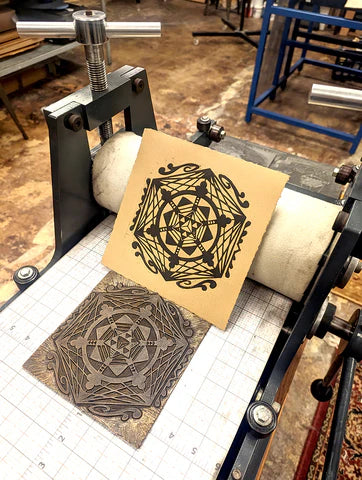Make Your Own Professional Quality Relief Ink with printmaker, Vanessa Jo Bahr!
With just a few natural ingredients, you can create a completely non-toxic, archival and professional quality, oil-based printmaking ink with this easy step-by-step tutorial.

Ingredients:
- Earth & Mineral Pigment
- #00 Burnt Plate Oil
- Magnesium Carbonate
- Liquid Gum Arabic (optional)
Supplies:
- Carved Wood or Linoleum Block
- Glass Palette
- Muller
- Ink Knife
- Brayer
Step 1: Scoop out 1 part pigment (e.g. 1 tsp.) into a mound and press down to make an indentation.

Step 2: Add ¾ part (e.g. ¾ tsp.) #00 burnt plate oil to the pigment.

Step 3: Using an ink knife, mix oil and pigment together until evenly distributed. You will know it is thoroughly mixed when you achieve a shiny ink without any loose powdered pigment.


Step 4: Using a glass muller, continue to mull your ink mixture (rubbing in circles, then scraping ink off the bottom and repeating). The purpose of mulling is to evenly distribute the oil binder among the pigment particles. It is not meant to grind the pigments; therefore, you don’t need to use excessive pressure.


Step 5: The more time you spend mulling, the better your ink will be. At least 3 rounds of scraping the ink off the muller and re-mulling is best. The more ink you are mixing the longer you will want to mull. This ink was mulled for about 5 minutes in total.

Step 6: Add 1 part magnesium carbonate (e.g. 1 tsp.) to your ink mixture. After mixed, mull your ink one final time to assure proper distribution of ingredients.

Step 7: OPTIONAL – Add a couple drops of gum arabic solution to your ink mixture and mix thoroughly. Introducing gum arabic will make your ink adhere to the paper better and less likely to rub off.
Step 8: Roll out your ink using a brayer.

Step 9: Ink up your block.

Step 10: Place your paper on top and run through the press. Alternatively, you can hand burnish using a spoon, or barren then pull your print!


Step 11: Clean Up: Use Eco-Solve (a plant-based and non-toxic solvent) to clean blocks, glass surface, muller, brayer and ink knife. Use Pinerite (a plant-based hand cleaner) to clean ink off hands and skin.


Find more of Vanessa's beautiful work using natural materials at....
Instagram: @VanessaJoBahr
Website: https://vanessajo.

What is "Burnt Plate Oil"? Burnt plate oil is linseed oil (aka flaxseed oil) which has been heated until it has become thick and viscous. The higher the number, the thicker the plate oil. We don't carry it but it's available online.




